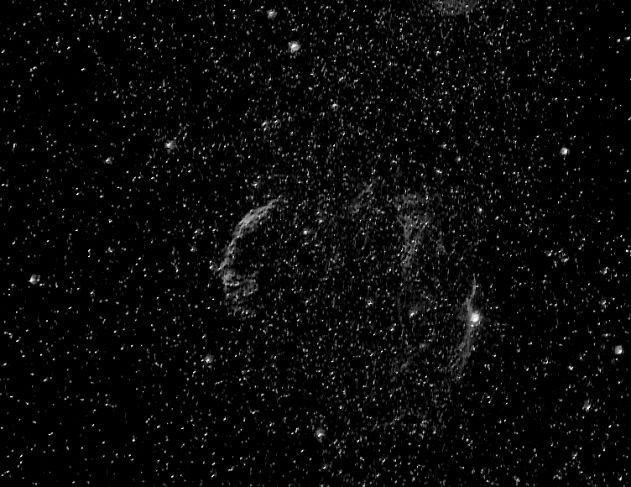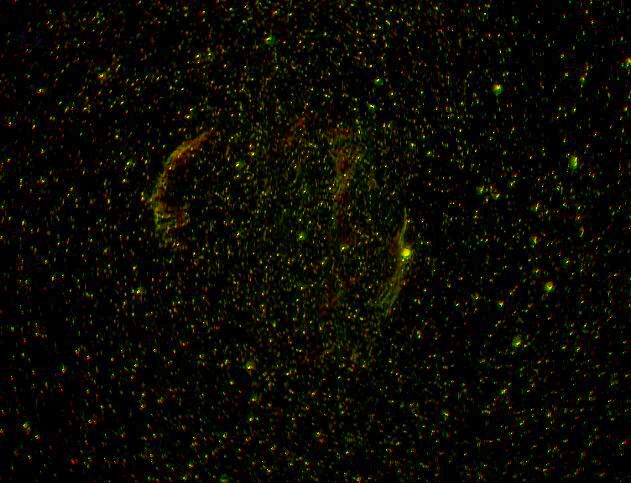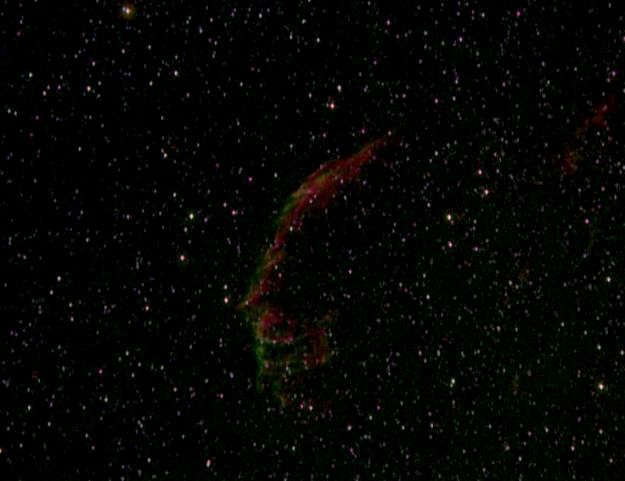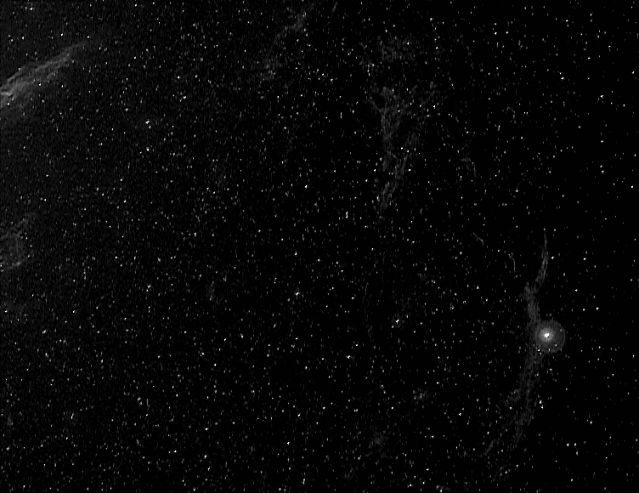

The Veil Nebula is the remanent of a supernova that exploded about 8,000 years ago. The debris has formed an expanding ring which is now known as the Cygnus Loop. The name Veil Nebula generally refers to the visible parts of the ring which is so large that several NGC numbers have been assigned to it (see the mouseover of the first image). These parts have a variety of names associated with them.
The Western Veil (to the right of my image) is C34 or NGC 6960 also known as the Witches Broom.
The Eastern Veil (to the left of my image) is C33 or NGC 6992 with NGC 6995 and IC 1340 to its south (below on my image).
Pickering's Triangle is the northern-most part of the loop and can be seen between the eastern and western veils.
The main part of the nebula was discovered by William Herschel on 5th September 1784. Pickering's Triangle was discovered on photographs by Williamina Fleming in 1904 (after the NGC catalogue was produced) but credit went to Edward Pickering who was the director of the observatory.
Although the nebula has an integrated magnitude of 7, it is spread out over such a large area that its surface brightness is quite low and it is difficult to see. However it is an emission nebula, so much of its light is emitted by ionised Oxygen and an OIII filter can render it visible. It is even brighter in emission from Hydrogen so that photographically its shows best in Hα light. High-resolution images show filaments which are thought to be the result of thin shells of material which are only visible when edge on to us.
 |
The Veil Nebula in full. Move your mouse over the image to see the NGC designations of its parts. In addition to those shown, there is NGC 6974 which is just south of NGC 6979 but I cannot distinguish it clearly on my picture. (I am surprised that these two received NGC designations but that Pickering's Triangle was missed at the time. Maybe the triangle is much fainter in OIII than it is in Hα. See below.) Date and Time: 16th October 2011 22:12 to 21:33 UT Camera: MX716 Telescope: 58-mm SLR lens with Astronomik Hα filter. Capture: star_mx7. 5 frames, 300" exposure. Processing: star_mx7. Background, non-linear stretch 25. Registax. Stacked 5 frames, gamma 1.4, histogram 22-255. Focus Magic: blur 2, motion 4. PhotoImpact: reduction to 84%, gamma 1.4, brightness -6. |
 |
In order to try to answer my question (above), I took these pictures in OIII and Hα. Here I have combined them with Hα in red and OIII in green (nothing in blue so the stars look yellow). Move your mouse pointer over the image to see more natural-looking colour produced by putting the OIII image in the blue channel as well. It doesn't look as though NGCs 6974 and 6979 are any brighter than Pickering's Triangle even in OIII light, so I remain mystified as to why Pickering's Triangle was missed. Date and Time: 16th October 2011 22:12 to 21:33 UT Camera: MX716 Telescope: 58-mm SLR lens with Astronomik Hα and OIII filters. Capture: star_mx7. 5 frames, 300" exposure for each colour. Processing: star_mx7. Background, non-linear stretch 25. Registax. Stacked 5 frames for each colour. K3CCDTools. Aligned the two pictures and exported them as bmp images. Photoshop. Combined the images into a single RGB image. PhotoImpact: gamma 1.4, removal of background-colour, colour saturation +25, reduction to 84%, further gamma and background correction. |
 |
The Eastern Veil in false colour. The image as made from pictures taken with Hα, OIII, and SII filters, assigning Hα to red, OIII to green and SII to blue. Date and Time: 15th October 2011 20:48 to 22:04 UT Camera: MX716 Telescope: 135-mm SLR lens with Astronomik Hα, OIII, and SII filters. Capture: star_mx7. 10 frames, 120" exposure for each colour. Processing: star_mx7. Background, non-linear stretch 25. Registax. Stacked 10 frames for each colour. K3CCDTools. Aligned the three pictures and exported them as bmp images. Photoshop. Combined the images into a single RGB image. PhotoImpact: gamma 1.4, removal of background-colour, colour saturation +25, reduction to 84%, further gamma and background correction. |
 |
The Western Veil or Witches Broom is in the bottom, right-hand corner. I put it there so as to include Pickering's Triangle and a small part of the Eastern Veil (in the top, left-hand corner). The bright star in front of the nebula is the 4th magnitude 52-Cygni. The picture was taken with H-alpha light. Date and Time: 15th October 2011 22:14 to 22:27 UT Camera: MX716 Telescope: 135-mm SLR lens with Astronomik Hα filter. Capture: star_mx7. 3 frames, 120", 180" and 300" exposure. Processing: star_mx7. Background, non-linear stretch 25. Registax. Stacked 3 frames. Focus Magic: blur 1, motion 4 PhotoImpact: reduction to 84%, gamma 1.4, brightness -5. |
Home Back to DSOs